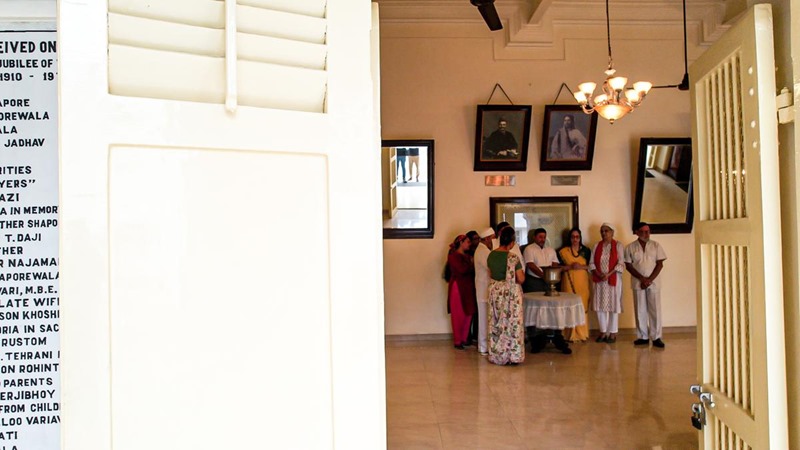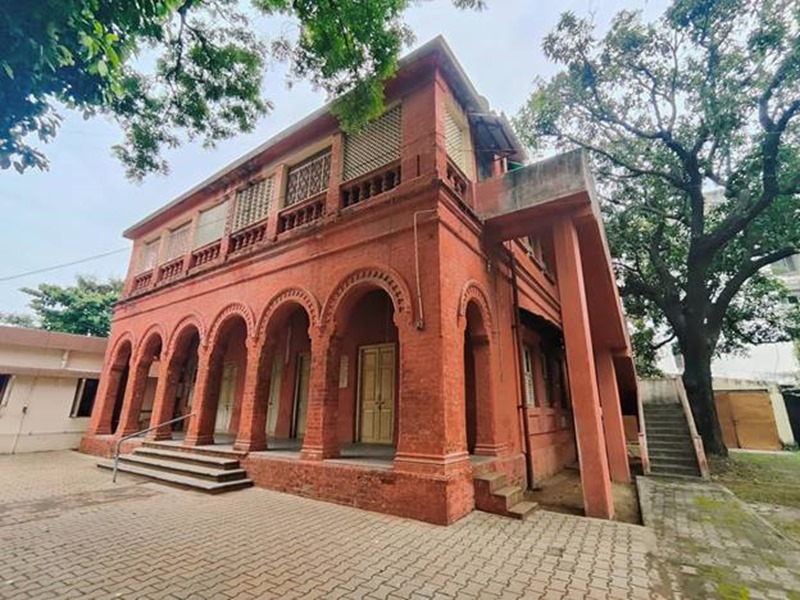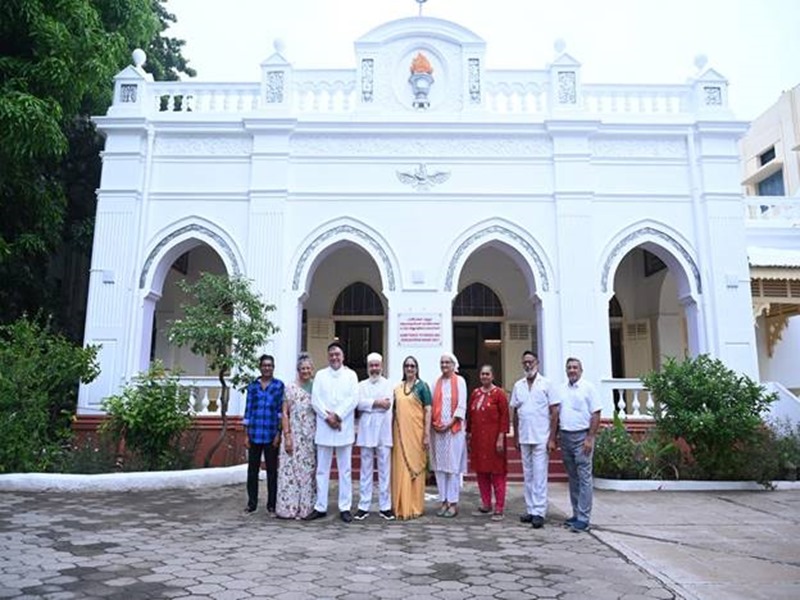Not many have the privilege of stepping into the Parsi fire temple. This Madras Day, we meet members of Chennai’s Parsi community at the recently renovated Jal Phiroj Clubwala Dar-e-meher, and the graceful red brick Parsi Anjuman Baug Dharamshala
Article by Shonali Muthalaly | The Hindu
A prayer meeting inside the Parsi fire temple. | Photo Credit: Johan Sathyadas
In the chaos of Royapuram’s congested traffic and crowds, a peahen struts.
Like the bird, we soak up the peace on the quiet campus of the 115-year-old Parsi Anjuman Baug Dharamshala. As we peer up at statuesque red brick building. Tehnaz Bahadurji, one of the historians of the Parsi community, discusses how they have been working on learning more about its unique architecture, amid plans to renovate it.
“Architect friends have told us it could be the work of Robert Chisholm, or Henry Irwin, who came after him,” she says, adding, “Or it could be by Thatikonda Namberumal Chetty, who worked with Irwin, and went on to construct buildings on his own after that,” she says.
British architect Chisholm is credited with pioneering the Indo-Saracenic style of architecture in Madras, with Presidency college and the University of Madras. Irwin followed, with the Madras High Court and Connemara library. Chetty, known as Irwin’s chief associate, constructed many city landmarks through the 19th and early 20th centuries including the Government Museum, YMCA and Connemara Library . (His other claim to fame was the fact that he was the first Indian in Madras to own a car.)
Built to house travellers, the Anjuman Baug has two rooms inside with attached bathrooms and a dining room. The second floor that was added about 60 years ago, in built in a similar style. It predates the Parsi Fire temple Jal Phiroj Clubwala Dar-e-meher, by 2 and half years. Set less than 200 metres away, the temple was built in 1910 in memory of Jal, the young son of philanthropist Phiroj Clubwala.
Explaining how the Parsis moved to India more than 1200 years ago to escape religious persecution, Zarine Mistry, also a community historian says that a delegation met the Governor of Fort St George 1809, and Hirjibhai Kharas, who was one among them became the first Parsi in Madras.
The Anjuman Baug Dharamshala | Photo Credit: Johan Sathyadas
“The Parsis brought a small plot of land right here, in 1795,” says Zarine, as we look around the expansive campus, which includes a burial ground. By 1799, they expanded the area and by 1822, it was about 32 grounds, leased from the East India Company. “When the Crown took over in 1858, all lands on a 99-year-old lease were given to the lessees, and by 1895 we got proper documentation,” says Zarine.
Today, the Parsis number about 45,000 people in India, of which less that 250 live in Chennai. The tight-knit Chennai community is held together by three central bodies: The Madras Parsi Zarthosti Anjuman (MPZA), the fire temple trust and the cultural association. They have been gathering at the Parsi club, started in the 1930s in the same neighbourhood, once a month for the last 30 years.
We move to the recently renovated Fire temple, which recently turned 113. As we study the graceful building from a garden bright with flowers, Darius Bahadurji, the imposing, yet jovial, President of the Anjuman and fire temple, explains how challenging the renovation was since it included cleaning the chimney, without disturbing the fire that burns constantly, being fed 5 times through the day with sandlewood by the priest.
Darius Bahadurji, President of the Anjuman and fire temple | Photo Credit: Johan Sathyadas
Tehnaz adds, ‘For the first 100 years, though there was a community living here, we had no place of worship, until this was built.” Built in a style that is typical of fire temples, it has a verandah and a statuesque hall for congregation, lit with sunshine, mirrors and chandeliers. Above the doors are arched stained glass windows, which add an intricate burst of colour when the sun filters though.
“We work together harmoniously, to keep the community together,” says Darius, emphasising that the committee’s role is to not just preserve the Parsi legacy in Chennai, but also to look after their own, while continuing to contribute to the city. With one renovation done, they are gearing up for the next big challenge: renovating the Anjuman Baug.
The project is likely to prove to be expensive and time-consuming. However, Tehnaz states, “We plan to do it with the support of the our community here. Even though it is miniscule, we have great hope.”
At the Parsi Fire temple in Royapuram | Photo Credit: Johan Sathyadas





Thanks for a very informative article – wonderful to see the Madras anjuman proudly looking after this beautiful building & its history.
May this community GROW !